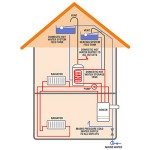Gas Boiler Ventilation Requirements: TOP Rules to Obey
Usually gas boilers are installed in dark private areas of a house or apartment (for example, basements), where they are hooked up to the gas line. For many owners this is a pretty nice variant, as there’s no need to look at the boiler the entire time. However, providing periodic maintenance is also very important, as well as following basic gas boiler ventilation requirements.

What is proper ventilation required for? It’s essential for:
- removing condensation
- dissipating the heat
- providing relief air to overcome the effects of cooker hoods, tumble dyers and fans
- providing air changes within a room for the living environment improvement
So, what are those essential regulations to follow?
Primer Gas Boiler Ventilation Requirements
- Before making any alterations to your place, it is important to get professional advice on fueling and ventilation. Contact your fuel supplier for qualified personnel and additional advice.
- The boiler room must have a constant positive pressure when compared with the outside. This is important for the minimization of back-drafting of fuel gases into the space. When the space has back-drafting issues, use a smoke tube.
- The boiler compartment should have gas dispersion holes right in the bottom of the boiler cabinet to prevent build up of LPG in the event of leaks, which is very dangerous. Within the cabinet, there should be appliance isolated taps available.
- The boilers should be at certain pressure that is tested with the help of a hydrostatic pressure test. Pressure vessels and boilers shouldn’t have more than 1? times the maximum working pressure, except those of automobiles that are tested to 1? times the maximum working pressure.
- The pressure should be kept under appropriate observation for it not to exceed the required pressure by 6%.
- A lap-seam is a joint that attaches metal sheets by brazing, soldering, welding and riveting. If there is a crack in the longitudinal riveted joint of the shell, drum or vessel, the boiler can’t be used. It should be repaired.
- Ensure that the rooms containing heating appliances are ventilated in a proper way – don’t block the vents.
- When creating a new living space, make sure that it has ventilation in accordance with Building Regulations.
- Ventilate using direct outdoor air, providing sufficient exhaust stacks. This will prevent the reentering of the exhausted air.
- The amount of air needed for cooling and ventilation in the boiler room is predetermined by the heat loss from the boiler jacket, stacks, breechings, shell, piping or other heat-generating equipment within the room.
- Annual gas safety checks are obligatory and are the minimum requirement. All testing and examination work should be carried out by engineers with valid qualifications.
These basic gas boiler ventilation requirements will be pretty useful, while you’re making alterations to your place. Follow them to ensure your safety and gas boiler efficiency.
- popular
- new






